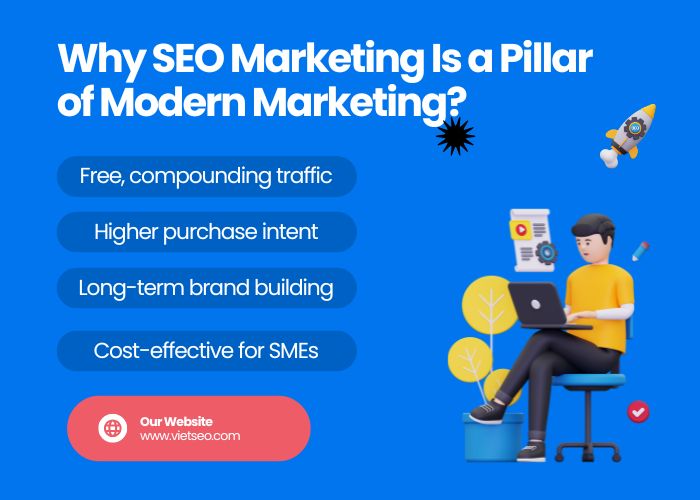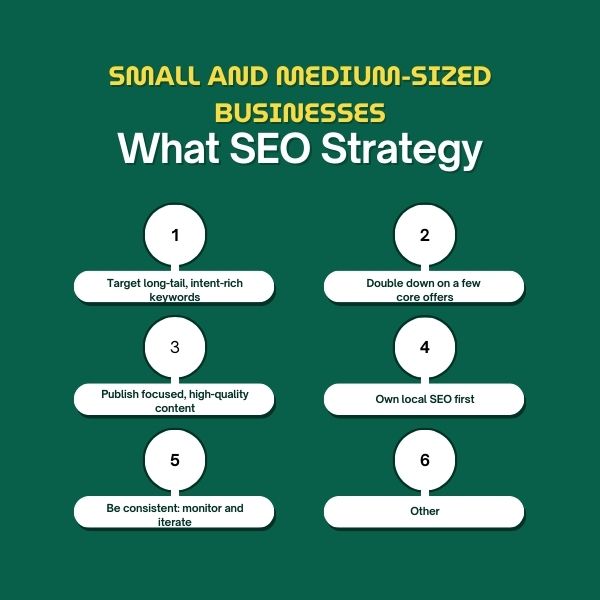Modern SEO Marketing Strategy for Small & Medium-Sized Businesses | Viet SEO
Unlike pay-per-click (PPC) advertising, SEO marketing doesn’t buy visibility—it earns it. The focus is on publishing genuinely helpful content, improving the technical foundations of your site (speed, mobile experience, crawlability, structured data), and building enough credibility to maintain high, stable rankings on search engine results pages (SERPs). The payoff is momentum: as your content library grows and your site becomes easier for users and search engines to navigate, results compound over time.
Why SEO Marketing Is a Pillar of Modern Marketing?
-
Free, compounding traffic
With PPC, traffic stops the moment your budget pauses. Strong SEO pages can attract visitors for months or even years with only periodic updates—making acquisition costs trend down over time.
-
Higher purchase intent
People who search are actively trying to solve a problem (“best CRM for small business,” “dentist near me”). That intent often translates into higher conversion rates than passive channels.
-
Long-term brand building
Showing up repeatedly for important queries signals authority. Consistent organic visibility builds trust, increases branded searches, and positions your business as the go-to resource in your niche.
-
Cost-effective for SMEs
Small and medium-sized businesses can compete by targeting specific topics, long-tail keywords, and local intent. One well-crafted article or landing page can drive leads long after it’s published.
Independent research backs this up: according to BrightEdge, organic search drives over 53% of total website traffic—outperforming both paid ads and social media.
10 Steps to Build a Modern SEO Marketing Strategy
Below is a practical, step-by-step process for designing and optimizing an SEO marketing campaign—tailored for small and medium-sized businesses.
Step 1: Set Clear, Measurable Goals (Before Anything Else)
Every strong SEO plan starts with outcomes, not keywords. Define SMART goals (Specific, Measurable, Achievable, Relevant, Time-bound) and tie them to business results.
Good examples
- Grow qualified organic traffic +50% in 6 months (from 4,000 → 6,000 monthly sessions).
- Reach Top 3 for 10 revenue-driving product keywords within 9 months.
- Increase monthly sales from organic by 30% (measured in orders or MQLs).
Why it matters: Goals guide how you choose keywords, which content formats to produce, what technical fixes to prioritize, and how you allocate budget.
Pro tip: Establish a baseline now (current traffic, rankings, conversions) so you can measure real improvement later.
Step 2: Understand Your Customers—Then Match Their Intent
Keyword lists come second. First, get crystal clear on who you’re serving and what they need at each stage of the buyer journey.
Map the journey
- Awareness: They’re learning about a problem.
Queries: “How to manage customer data securely?”, “What is CRM?”
- Consideration: They’re comparing solutions.
Queries: “CRM for SMEs,” “Software A vs Software B,” “Best CRM under $50”
- Decision: They’re ready to act.
Queries: “Buy CRM software,” “CRM pricing,” “Book CRM demo”
What to capture
- Pain points, desired outcomes, objections.
- Preferred formats (guides, checklists, comparisons, demos).
- Decision triggers (social proof, ROI, integrations, support).
Why it matters: Modern SEO wins when keywords align with search intent—not just search volume. Content that directly answers the user’s job-to-be-done earns higher clicks and conversions.
Step 3: Use Professional Tools to Build a Smart Keyword Plan
Invest in tools that help you find, qualify, and prioritize opportunities.
Essential toolkit
- Ahrefs / SEMrush: Keyword discovery, difficulty scoring, SERP analysis, competitor gaps, backlinks.
- Google Keyword Planner: Free starting point for volume trends.
- Ubersuggest: Budget-friendly expansion and quick difficulty estimates.
- Google Search Console: See your real queries, clicks, CTR, and ranking movement.
How to prioritize
- Favor medium-difficulty keywords with solid volume and clear intent.
- Look for click potential (some SERPs are dominated by ads/instant answers).
- Target long-tail and local variations for quicker wins (e.g., “CRM for small dental clinics in HCMC”).
- Cluster related queries into topics so one strong pillar page can support multiple subpages.
Quick workflow
- Start with seed terms (products/services + problems your customers describe).
- Expand with tool suggestions and competitor pages.
- Score by intent → difficulty → volume → business value.
- Group into clusters and map each cluster to a content type (guide, comparison, landing page).
- Build a simple backlog with priority, owner, and ETA.
Step 4: Choose Keywords Based on the Customer Journey
An effective SEO marketing strategy doesn’t revolve solely around product keywords. Group keywords by funnel stage:
| Stage | Example Keywords | Recommended Content Type |
|---|---|---|
| Awareness | “Why use customer management software?” | Blog articles, case studies |
| Consideration | “Compare software A vs. B” | Reviews, comparison posts |
| Decision | “Buy customer management software” | Landing pages, quotes, demos |
Awareness
Top Funnel- Keywords
- “Why use customer management software?”
- Content
- Blog articles, case studies
Consideration
Mid Funnel- Keywords
- “Compare software A vs. B”
- Content
- Reviews, comparison posts
Decision
Bottom Funnel- Keywords
- “Buy customer management software”
- Content
- Landing pages, quotes, demos
Step 5: Create SEO-Optimized Content
Content still wins—if it matches intent and delivers depth.
What “great” looks like
- Intent match first: Answer the exact question/problem the user brought to Google.
- Depth & authority: Include definitions, steps, examples, benchmarks, FAQs, and sources. Show experience (E-E-A-T).
- On-page optimization:
- Compelling title (H1) and SEO title with your primary keyword.
- Meta description that sells the click (benefit + outcome).
- H2/H3 structure, short paragraphs, scannable lists.
- Primary & secondary keywords woven naturally (no stuffing).
- Optimized images (descriptive filenames, alt text, compression).
- Internal links to related pages; add 1–2 external authoritative sources.
- Conversion cues: Clear CTAs, trust badges/testimonials, and next steps.
Helpful tools: SurferSEO/Frase (content briefs), Yoast/Rank Math (on-page checks), Grammarly (readability).
Pro tip: Create a content brief template (target persona, intent, outline, questions to answer, internal links) to keep quality consistent.
Step 6: Optimize Website Technical Performance
If content is king, technical SEO is the highway it rides on.
Foundations
- Google Search Console connected; submit XML sitemap; clean robots.txt.
- HTTPS everywhere; fix mixed content.
- Mobile-first responsive layout; avoid intrusive interstitials.
Speed & Core Web Vitals
- Aim for LCP < 2.5s, INP < 200ms, CLS < 0.1.
- Compress and lazy-load images (WebP/AVIF), defer non-critical JS, inline critical CSS.
- Use HTTP/2 or HTTP/3, caching/CDN, Brotli compression, and preconnect/preload for key assets.
Site integrity
- Clean URL structure (kebab-case, readable).
- Proper 301s for moved content; fix 404/5xx; set canonicals to prevent duplicates.
- Handle pagination and faceted filters; ensure key pages render without JS when possible.
- Add structured data (BreadcrumbList, Article/Product/LocalBusiness).
What to check weekly: PageSpeed Insights, GSC Coverage/Enhancements, server error logs.
Step 7: Build High-Quality Links
Links still matter—a lot. Prioritize quality, relevance, and natural growth.
Earned links that work
- Linkable assets: Data studies, original research, calculators, templates, local resources.
- Digital PR: Pitch industry publications, podcasts, newsletters; leverage timely angles.
- Guest expertise: Publish on reputable niche blogs with valuable, non-sales content.
- Unlinked mentions: Find and request attribution for brand references.
- Broken-link building: Offer your page as a replacement.
Internal links = hidden power
- Build topic clusters; link from pillar → cluster and cluster ↔ cluster.
- Use descriptive, varied anchor text; surface money pages from high-authority posts.
Avoid: Link farms, paid link schemes, over-optimized anchors, irrelevant directories.
Step 8: Local SEO – A Big Opportunity for SMEs
Own your neighborhood before chasing the world.
Google Business Profile (GBP)
- Complete categories, services, description, hours, attributes.
- Add high-quality photos, weekly posts, Q&A.
- Use UTM tags on website/CTA links to measure impact.
On-site local signals
- Create unique location/service pages (not copy-paste).
- Prominent NAP (name, address, phone), embedded map, click-to-call.
- Add LocalBusiness/Service schema, FAQs, reviews markup.
Reputation & citations
- Consistent NAP across major directories; build niche/local citations.
- Proactively request reviews; respond to all (especially negatives) with care.
Local links: Sponsor community events, partner with chambers, collaborate with nearby businesses.
Step 9: Manage SEO Projects with Real Ops
Great SEO is 50% execution discipline.
Workflow & tooling
- Trello / ClickUp / Notion: Backlog → brief → draft → edit → design → QA → publish → refresh.
- Google Sheets/Airtable: Keyword master, content calendar, on-page checklist, link log.
- Looker Studio: KPI dashboards (traffic, rankings, conversions, CVR, ROI).
Process to lock in
- Standardized content briefs and QA checklists (titles, meta, headers, links, schema, CWV).
- RACI (who’s Responsible, Accountable, Consulted, Informed).
- Biweekly sprint planning; define acceptance criteria for “done”.
- Automate alerts (GSC drops, 404 spikes) via email/Slack.
Step 10: Monitor → Analyze → Adjust (Continuous Improvement)
SEO is iterative. Ship, learn, refine.
Measure
- Traffic & conversions (GA4), assisted conversions, key events (demo, add-to-cart, lead form).
- Rankings for primary keywords (track by device/location).
- Engagement: CTR (Search Console), time on page, scroll depth, exit rate.
- Technical: Core Web Vitals, crawl/index coverage, error rates.
Improve
- Refresh aging winners (add sections, update stats, improve visuals).
- Consolidate cannibalized pages; redirect thin/duplicate content.
- A/B test titles/metas for CTR; tighten intros and subheads for engagement.
- Expand clusters where you’re gaining traction; prune where ROI is low.
- Align pages with product or pricing changes immediately.
Cadence: Formal review every 1–3 months; mini-checks weekly. Tie changes to KPIs so you know what actually moved the needle.
What SEO Strategy Works Best for Small and Medium-Sized Businesses?
You don’t need a huge budget to win with SEO—you need focus and consistency. Here’s a practical playbook for SMEs.
-
Target long-tail, intent-rich keywords
Go after specific queries with clear buying intent (e.g., “CRM for dental clinics,” “accounting service in District 1”). They’re easier to rank for and convert better. Use Google Search Console, “People also ask,” and competitor gaps in Ahrefs/SEMrush to find them.
-
Double down on a few core offers
Pick 3–5 products/services that drive profit. Build one strong pillar page for each, supported by FAQs, comparisons, use cases, and testimonials. Add clear CTAs (demo, quote, call) and proof (logos, reviews, case studies).
-
Publish focused, high-quality content
Create problem–solution guides, “X vs Y” comparisons, pricing pages, and checklists that directly answer search intent. Structure with H2/H3s, use internal links, and add schema (FAQ, Product/Service) to improve visibility.
-
Own local SEO first
Optimize your Google Business Profile (categories, services, photos, posts), ensure consistent NAP across directories, collect and respond to reviews, and build location pages (“service + city/ward”). This is often the fastest path to leads.
-
Be consistent: monitor and iterate
Track weekly in GA4 & Search Console: traffic, conversions, rankings, and CTR. Refresh top performers, combine cannibalized pages, improve titles/metas, and fix technical issues (Core Web Vitals, 404s, redirects). Small, steady improvements compound.
Bottom line: Prioritize specificity (long-tail + local), concentrate on your best offers, and keep improving every month. That’s how SMEs turn SEO into a reliable growth channel.
Conclusion
A modern SEO marketing strategy isn’t about chasing rankings for their own sake—it’s about integrating SEO with your broader marketing (content, brand, ads, and sales) so organic visibility turns into qualified leads and real revenue. When SEO aligns with business goals, results compound: stronger content earns links, technical fixes improve user experience, and every new page lifts the overall site.
With a clear, structured process, any small or medium-sized business can build an SEO plan tailored to its budget and growth targets in today’s digital-transformation era.
If you’re ready to execute this the right way, Viet SEO can help. With 18+ years of experience supporting hundreds of Vietnamese SMEs, we design and run SEO campaigns that deliver sustainable growth.
📞 Hotline: +84 917 212 969




